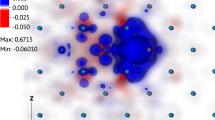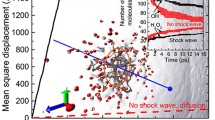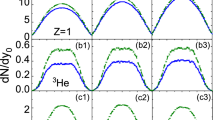Abstract
Variations of the threshold of swift heavy ion track formation with the ion energy and mass are studied here. We apply the hybrid multiscale approach combining TREKIS-3 code describing the electronic kinetics with the classical molecular dynamics tracing the evolution of the excited lattice. The results demonstrate that with a lowering of the energy loss curve (by choosing lighter ions for irradiation), the high-velocity threshold starts to shift down, whereas the low-velocity one remains constant until the thresholds meet. For certain ion parameters, a situation is possible in which both thresholds (low- and high-velocity) lie at the low-energy shoulder of the Bragg curve which results from the mismatch between the ion energy positions of the maximal track radius and the Bragg peak.





Similar content being viewed by others
References
Komarov FF (2017) Nano-and microstructuring of solids by swift heavy ions. Phys Uspekhi 60:435–471. https://doi.org/10.3367/UFNe.2016.10.038012
Lang M, Djurabekova F, Medvedev N et al (2020) Fundamental phenomena and applications of swift heavy ion irradiations. Comprehensive nuclear materials. Elsevier, pp 485–516
Medvedev N, Volkov AE, Rymzhanov R et al (2023) Frontiers, challenges, and solutions in modeling of swift heavy ion effects in materials. J Appl Phys 133:100701. https://doi.org/10.1063/5.0128774
Rogozhkin SV, Bogachev AA, Nikitin AA et al (2021) TEM analysis of radiation effects in ODS steels induced by swift heavy ions. Nucl Instrum Methods Phys Res Sect B Beam Interact with Mater Atoms 486:1–10. https://doi.org/10.1016/J.NIMB.2020.10.017
Yemini M, Hadad B, Liebes Y et al (2009) The controlled fabrication of nanopores by focused electron-beam-induced etching. Nanotechnology 20:245302. https://doi.org/10.1088/0957-4484/20/24/245302
Notthoff C, Jordan S, Hadley A et al (2020) Swift heavy ion irradiation of GaSb: from ion tracks to nano-porous networks. Phys Rev Mater 4:046001. https://doi.org/10.1103/PhysRevMaterials.4.046001
Peinetti AS, Lake RJ, Cong W et al (2021) Direct detection of human adenovirus or SARS-CoV-2 with ability to inform infectivity using DNA aptamer-nanopore sensors. Sci Adv 7:eabh2848. https://doi.org/10.1126/SCIADV.ABH2848
Choudhury N, Singh F, Sarma BK (2013) Effect of swift heavy ion irradiation on lead sulfide quantum dots embedded in polyvinyl alcohol. Radiat Eff Defects Solids 168:498–503. https://doi.org/10.1080/10420150.2012.761995
Gismatulin A, Skuratov V, Volodin V, et al (2019) Swift heavy ion stimulated formation of the Si quantum dots in Si/SiO2 multilayer heterostructures. In: Lukichev VF, Rudenko K V (eds) international conference on micro- and nano-electronics 2018. SPIE, p 71
Schwen D, Bringa E, Krauser J et al (2012) Nano-hillock formation in diamond-like carbon induced by swift heavy projectiles in the electronic stopping regime: experiments and atomistic simulations. Appl Phys Lett 101:113115. https://doi.org/10.1063/1.4752455
Touboul AD, Privat A, Arinero R et al (2012) Swift heavy ion-induced silicon dioxide nanostructuration: experimental observation of velocity effect. Eur Phys J Appl Phys 60:10402. https://doi.org/10.1051/epjap/2012120349
Lang M, Voss K, Neumann R (2005) Influence of ion velocity on the track morphology in dark mica. GSI Sci Rep 3:343. https://doi.org/10.13140/RG.2.2.15219.58401
Skuratov VA, O’Connell J, Kirilkin NS, Neethling J (2014) On the threshold of damage formation in aluminum oxide via electronic excitations. Nucl Instrum Methods Phys Res Sect B Beam Interact with Mater Atoms 326:223–227. https://doi.org/10.1016/j.nimb.2013.10.037
Xu L, Rymzhanov RA, Zhai P et al (2023) Direct fabrication of sub-10 nm nanopores in WO3 nanosheets using single swift heavy ions. Nano Lett 23:4502–4509. https://doi.org/10.1021/ACS.NANOLETT.3C00884
Karlusic M, Ghica C, Negrea RF et al (2017) On the threshold for ion track formation in CaF2. New J Phys 19:23023. https://doi.org/10.1088/1367-2630/aa5914
Szenes G, Pécz B (2016) Anomalous effect of ion velocity on track formation in GeS. Nucl Instrum Methods Phys Res Sect B Beam Interact with Mater Atoms 389–390:17–22. https://doi.org/10.1016/J.NIMB.2016.11.008
Meftah A, Brisard F, Costantini JM et al (1993) Swift heavy ions in magnetic insulators: a damage-cross-section velocity effect. Phys Rev B 48:920–925. https://doi.org/10.1103/PhysRevB.48.920
Rymzhanov RA, Gorbunov SA, Medvedev N, Volkov AE (2019) Damage along swift heavy ion trajectory. Nucl Instrum Methods Phys Res Sect B Beam Interact with Mater Atoms 440:25–35. https://doi.org/10.1016/j.nimb.2018.11.034
Rymzhanov R, Medvedev NA, Volkov AE (2017) Damage threshold and structure of swift heavy ion tracks in Al2O3. J Phys D Appl Phys 50:475301. https://doi.org/10.1088/1361-6463/aa8ff5
Medvedev N, Volkov AE (2022) Nonthermal acceleration of atoms as a mechanism of fast lattice heating in ion tracks. J Appl Phys 131:225903. https://doi.org/10.1063/5.0095724
(2023) TREKIS-3. https://github.com/N-Medvedev/TREKIS-3
Medvedev NA, Rymzhanov RA, Volkov AE (2015) Time-resolved electron kinetics in swift heavy ion irradiated solids. J Phys D Appl Phys 48:355303. https://doi.org/10.1088/0022-3727/48/35/355303
Rymzhanov RA, Medvedev NA, Volkov AE (2016) Effects of model approximations for electron, hole, and photon transport in swift heavy ion tracks. Nucl Instrum Methods Phys Res Sect B Beam Interact with Mater Atoms 388:41–52. https://doi.org/10.1016/j.nimb.2016.11.002
Ritchie RH, Howie A (1977) Electron excitation and the optical potential in electron microscopy. Philos Mag 36:463–481. https://doi.org/10.1080/14786437708244948
Cullen DE (2018) EPICS2017: electron photon interaction cross sections: w-nds.iaea.org/epics/. Vienna
Kuhr J-C, Fitting H-J (1999) Monte Carlo simulation of electron emission from solids. J Electron Spectros Relat Phenomena 105:257–273. https://doi.org/10.1016/S0368-2048(99)00082-1
Medvedev N, Akhmetov F, Rymzhanov RA et al (2022) Modeling time-resolved kinetics in solids induced by extreme electronic excitation. Adv Theory Simul 5:2200091. https://doi.org/10.1002/ADTS.202200091
Thompson AP, Aktulga HM, Berger R et al (2022) LAMMPS—a flexible simulation tool for particle-based materials modeling at the atomic, meso, and continuum scales. Comput Phys Commun 271:108171. https://doi.org/10.1016/J.CPC.2021.108171
Matsui M (1996) Molecular dynamics simulation of structures, bulk moduli, and volume thermal expansivities of silicate liquids in the system CaO–MgO–Al2O3–SiO2. Geophys Res Lett 23:395–398. https://doi.org/10.1029/96GL00260
Stukowski A (2010) Visualization and analysis of atomistic simulation data with OVITO–the open visualization tool. Model Simul Mater Sci Eng 18:15012. https://doi.org/10.1088/0965-0393/18/1/015012
Rymzhanov RA, Medvedev N, O’Connell JH et al (2020) Insights into different stages of formation of swift heavy ion tracks. Nucl Instrum Methods Phys Res Sect B Beam Interact with Mater Atoms 473:27–42. https://doi.org/10.1016/j.nimb.2020.04.005
Acknowledgements
This work has been carried out in part using computing resources of the Federal collective usage center Complex for Simulation and Data Processing for Mega-science Facilities at NRC “Kurchatov Institute”, http://ckp.nrcki.ru/. The work of RR and AEV was funded by the Ministry of Education and Science of the Republic of Kazakhstan (grant number AP09259476). NM gratefully acknowledges financial support from the Czech Ministry of Education, Youth and Sports (grants No. LTT17015, LM2018114, and No. EF16_013/0001552).
Author information
Authors and Affiliations
Contributions
RAR: Conceptualization (equal), Methodology (equal), Software (equal), Formal analysis (lead), Visualization (lead), Writing-Original Draft (equal). NM: Conceptualization (equal), Methodology (equal), Software (equal), Writing-Original Draft (equal), Writing—Review & Editing (equal). AEV: Conceptualization (equal), Methodology (equal), Writing—Review & Editing (equal).
Corresponding author
Ethics declarations
Conflict of interest
The authors have no conflicts of interest to disclose.
Ethical approval
Not Applicable.
Additional information
Handling Editor: Yaroslava Yingling.
Publisher's Note
Springer Nature remains neutral with regard to jurisdictional claims in published maps and institutional affiliations.
Supplementary Information
Below is the link to the electronic supplementary material.
Rights and permissions
Springer Nature or its licensor (e.g. a society or other partner) holds exclusive rights to this article under a publishing agreement with the author(s) or other rightsholder(s); author self-archiving of the accepted manuscript version of this article is solely governed by the terms of such publishing agreement and applicable law.
About this article
Cite this article
Rymzhanov, R.A., Medvedev, N. & Volkov, A.E. Velocity effect in swift heavy ion irradiation: how the low- and high-energy track formation thresholds meet. J Mater Sci 58, 14072–14079 (2023). https://doi.org/10.1007/s10853-023-08898-2
Received:
Accepted:
Published:
Issue Date:
DOI: https://doi.org/10.1007/s10853-023-08898-2




